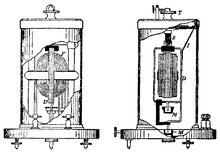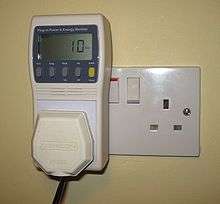Wattmeter
The wattmeter is an instrument for measuring the electric power (or the supply rate of electrical energy) in watts of any given circuit. Electromagnetic wattmeters are used for measurement of utility frequency and audio frequency power; other types are required for radio frequency measurements.

A wattmeter reads the average value of the product v(t)i(t) = p(t), where v(t) is the voltage with reference polarity in the ± terminal with respect to the other terminal of the potential (pressure) coil, and i(t) is the current with reference direction flowing into the ± terminal of the current coil. The wattmeter reads P = (1/T) ∫0T v(t)i(t) dt, which in sinusoidal steady-state reduces to Vrms Irms cos(φ), where T is the period of p(t) and φ is the angle by which the current lags the voltage.[1]
History
On 14 August 1888 in Oliver B. Shallenberge patent a watt-hour meter.The Hungarian Ottó Bláthy patent his AC Wattmeter.[2] In 1974 Maghar S. ChanaRamond L. KraleyEric A. HauptmannBarry and M. Pressman patent Electronic wattmeter. This device is made up from power, current and voltage transformers, who measure the average power.[3]
Electrodynamic
The traditional analog wattmeter is an electrodynamic instrument. The device consists of a pair of fixed coils, known as current coils, and a movable coil known as the potential coil.
The current coils are connected in series with the circuit, while the potential coil is connected in parallel. Also, on analog wattmeters, the potential coil carries a needle that moves over a scale to indicate the measurement. A current flowing through the current coil generates an electromagnetic field around the coil. The strength of this field is proportional to the line current and in phase with it. The potential coil has, as a general rule, a high-value resistor connected in series with it to reduce the current that flows through it.
The result of this arrangement is that on a DC circuit, the deflection of the needle is proportional to both the current (I) and the voltage (V), thus conforming to the equation P=VI.
For AC power, current and voltage may not be in phase, owing to the delaying effects of circuit inductance or capacitance. On an AC circuit the deflection is proportional to the average instantaneous product of voltage and current, thus measuring active power, P=VI cos φ. Here, cos φ represents the power factor which shows that the power transmitted may be less than the apparent power obtained by multiplying the readings of a voltmeter and ammeter in the same circuit.
The two circuits of a wattmeter can be damaged by excessive current. The ammeter and voltmeter are both vulnerable to overheating—in case of an overload, their pointers will be driven off scale—but in the wattmeter, either or even both the current and potential circuits can overheat without the pointer approaching the end of the scale. This is because the position of the pointer depends on the power factor, voltage and current. Thus, a circuit with a low power factor will give a low reading on the wattmeter, even when both of its circuits are loaded to the maximum safety limit. Therefore, a wattmeter is rated not only in watts, but also in volts and amperes.
A typical wattmeter in educational labs has two voltage coils (pressure coils) and a current coil. The two pressure coils can be connected in series or parallel to change the ranges of the wattmeter. The pressure coil can also be tapped to change the meter's range. If the pressure coil has range of 300 volts, the half of it can be used so that the range becomes 150 volts.
Electronic


Electronic wattmeters are used for direct, small power measurements or for power measurements at frequencies beyond the range of electrodynamometer-type instruments.
Digital
A modern digital wattmeter samples the voltage and current thousands of times a second. For each sample, the voltage is multiplied by the current at the same instant; the average over at least one cycle is the real power. The real power divided by the apparent volt-amperes (VA) is the power factor. A computer circuit uses the sampled values to calculate RMS voltage, RMS current, VA, power (watts), power factor, and kilowatt-hours. The readings may be displayed on the device, retained to provide a log and calculate averages, or transmitted to other equipment for further use. Wattmeters vary considerably in correctly calculating energy consumption, especially when real power is much lower than VA (highly reactive loads, e.g. electric motors). Simple meters may be calibrated to meet specified accuracy only for sinusoidal waveforms. Waveforms for switched-mode power supplies as used for much electronic equipment may be very far from sinusoidal, leading to unknown and possibly large errors at any power. This may not be specified in the meter's manual.
Precision and accuracy
There are limitations to measuring power with inexpensive wattmeters, or indeed with any meters not designed for low-power measurements. This particularly affects low power (e.g. under 10 watts), as used in standby; readings may be so inaccurate as to be useless (although they do confirm that standby power is low, rather than high).[4] The difficulty is largely due to difficulty in accurate measurement of the alternating current, rather than voltage, and the relatively little need for low-power measurements. The specification for the meter should specify the reading error for different situations. For a typical plug-in meter the error in wattage is stated as ±5% of measured value ±10 W (e.g., a measured value of 100W may be wrong by 5% of 100 W plus 10 W, i.e., ±15 W, or 85–115 W); and the error in kW·h is stated as ±5% of measured value ±0.1 kW·h.[5] If a laptop computer in sleep mode consumes 5 W, the meter may read anything from 0 to 15.25 W, without taking into account errors due to non-sinusoidal waveform. In practice accuracy can be improved by connecting a fixed load such as an incandescent light bulb, adding the device in standby, and using the difference in power consumption.[4] This moves the measurement out of the problematic low-power zone.
Radio frequency
Instruments with moving coils can be calibrated for direct current or power frequency currents up to a few hundred hertz. At radio frequencies a common method is a rectifier circuit arranged to respond to current in a transmission line; the system is calibrated for the known circuit impedance. Diode detectors are either directly connected to the source, or used with a sampling system that diverts only a portion of the RF power through the detector. Thermistors and thermocouples are used to measure heat produced by RF power and can be calibrated either directly or by comparison with a known reference source of power.[6] A bolometer power sensor converts incident radio frequency power to heat. The sensor element is maintained at a constant temperature by a small direct current. The reduction in current required to maintain temperature is related to the incident RF power. Instruments of this type are used throughout the RF spectrum and can even measure visible light power. For high-power measurements, a calorimeter directly measures heat produced by RF power.[6]
Watthour meters
An instrument which measures electrical energy in watt hours is essentially a wattmeter which accumulates or averages readings. Digital electronic instruments measure many parameters and can be used where a wattmeter is needed: volts, current,in amperes, apparent instantaneous power, actual power, power factor, energy in [k]W·h over a period of time, and cost of electricity consumed.
References
- Close, Charles M. "Chapter 8: Power and Energy". The Analysis of Linear Circuits. p. 395.
- Electric Meter
- US3959724A - Electronic wattmeter
- US Lawrence Livermore laboratory, Standby Power, measuring standby
- Data listed in text from manual for inexpensive plug-in electricity meter Brennenstuhl PM230. The lowest measurable current is given as 0.02 A, which corresponds to about 5 W at 230 VAC
- Joseph J. Carr, RF Components and Circuits, Newnes, 2002 ISBN 978-0-7506-4844-8 pages 351-370
External links
![]()
- DC Metering Circuits chapter from Lessons in Electric Circuits series